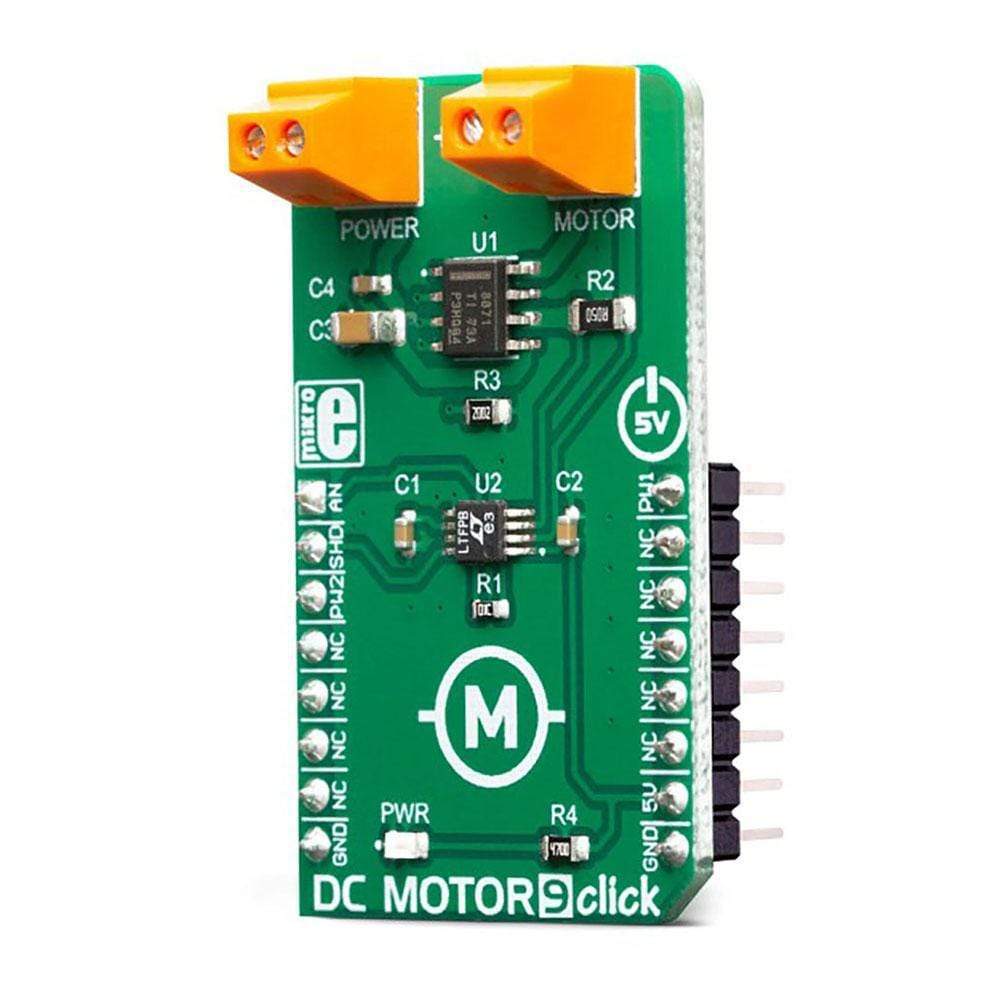
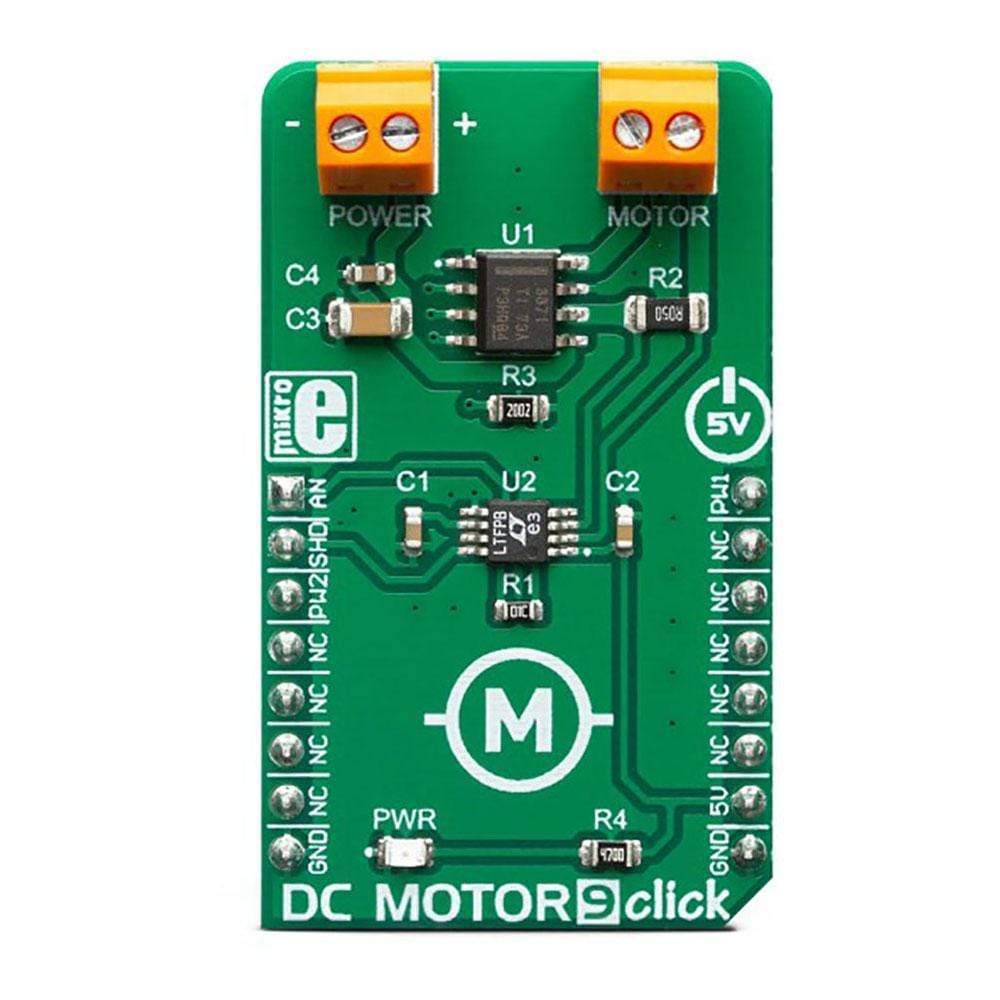
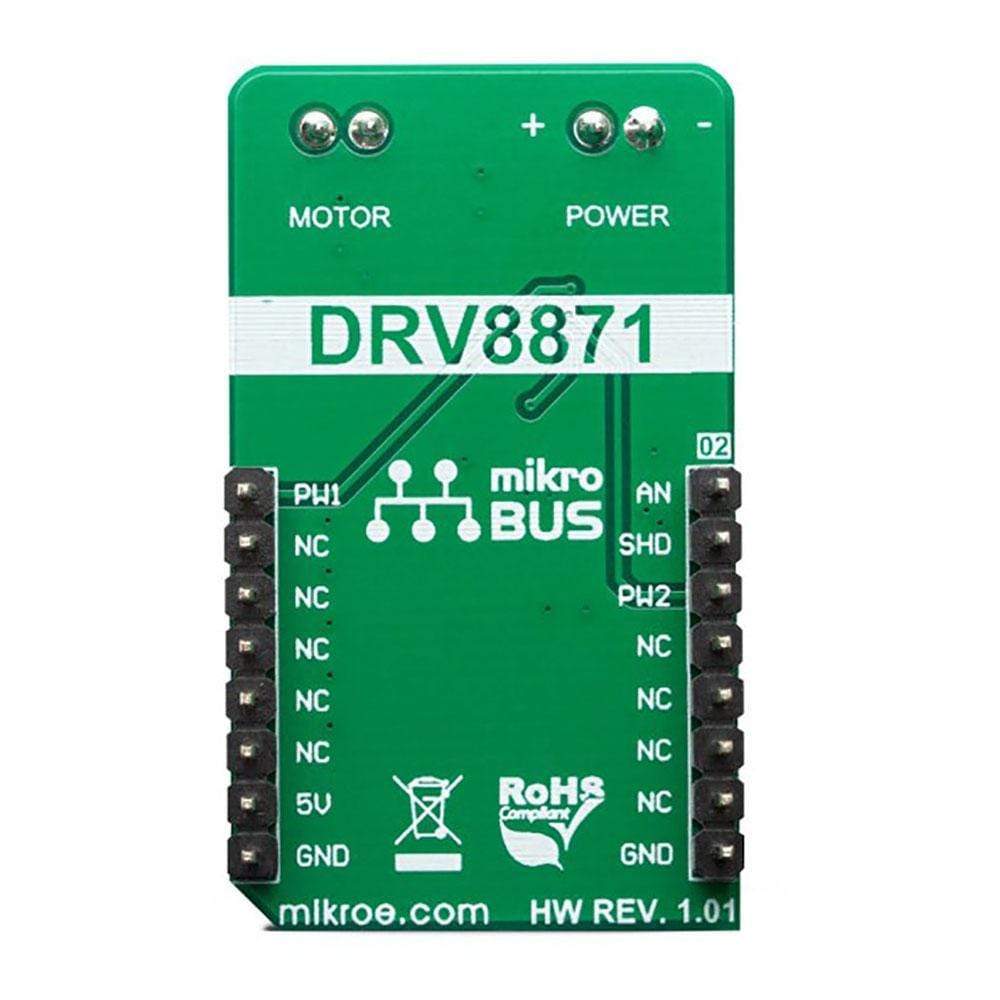
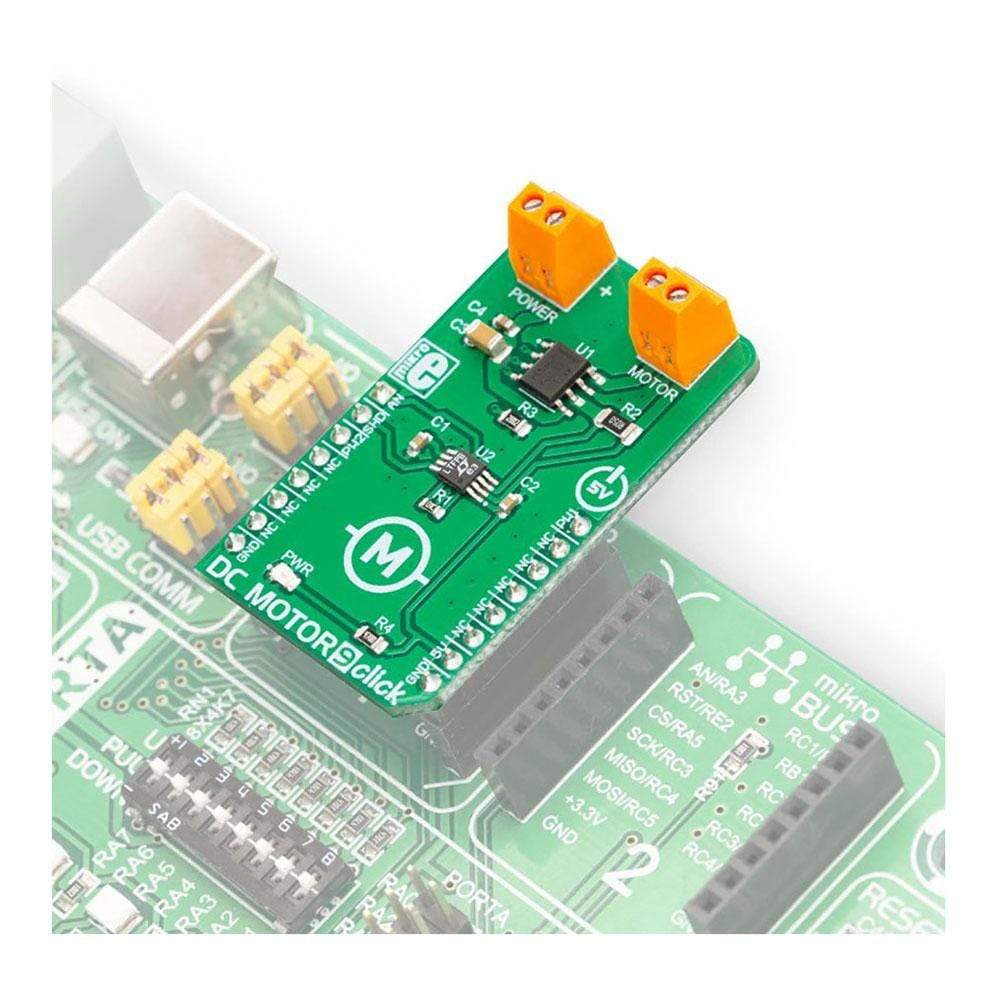
Overview
The DC Motor 9 Click Board™ is a brushed DC motor driver with the current limiting and current sensing. It is based on the DRV8871, an integrated H-Bridge driver IC, optimised for motor driving applications. It can be operated by two logic signals, allowing to drive the connected motor in two different ways: it can use fixed logic levels for the direction control, or it can be controlled by a PWM signal, offering an additional speed control option. The DRV8871 also contains a set of protection features, offering a very high level of reliability.
Besides driving capabilities, DC Motor 9 Click Board™ can also sense current consumption at its output.
Downloads
The DC Motor 9 Click Board™ is optimized for driving brushed DC motors. it integrates an efficient H-Bridge with very low ON resistance of approximately 500mΩ through each branch. An integrated sleep mode is activated when both logic inputs are at a LOW logic level for longer than 1ms, reducing the overall power consumption. A dedicated, high-precision current sensing amplifier IC is used to sense the current through motor coils, allowing the host MCU to perform current monitoring at all times. DC Motor 9 click is perfectly suited for rapid development of various DC motor driving applications, including home appliances, printers, industrial equipment, mechatronic applications, etc.
How Does The DC Motor 9 Click Board™ Work?
The DC Motor 9 Click Board™ is designed around two different ICs: the first IC is the DR8871, a brushed DC motor driver, with internal current sensing, by Texas Instruments. This IC is actually an integrated H-Bridge driver with the current regulation circuit that allows limiting the current through the connected load, with just a single resistor. Unlike many other solutions, no external sensing resistors are required. A very low ON resistance through the H-Bridge reduces the overall power dissipation, while an advanced control circuit injects dead-time intervals, whenever the outputs change their state, preventing current shoot-throughs. The DRV8871 integrates a set of protection features, including undervoltage, overcurrent, and overtemperature protection. Each of these events will cause the H-Bridge MOSFETs to be disabled. After a fault condition has been removed, the device will continue its operation.
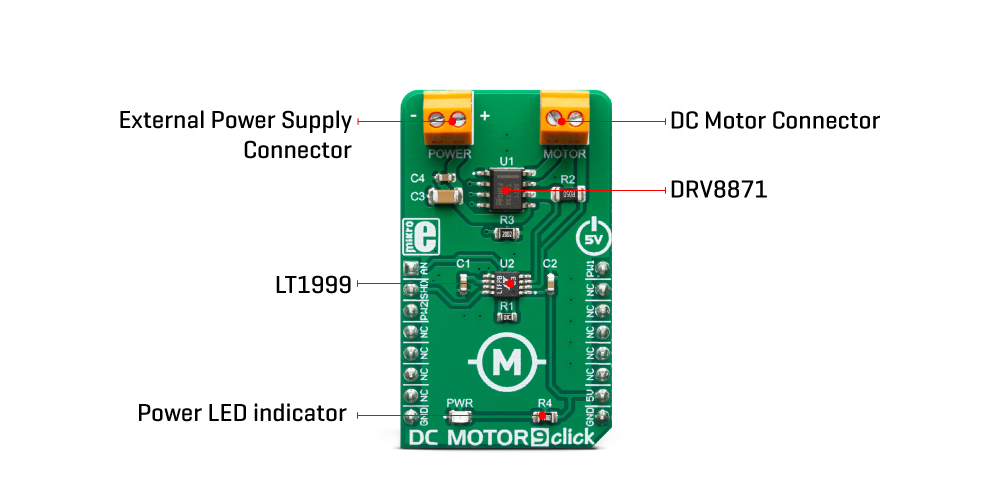
There are two methods that can be used to control the motor: the first method consists of applying a constant logic level to IN1 and IN2 inputs. While one of the inputs is held at a HIGH logic level, the other should be held at a LOW logic level. The direction of the motor rotation depends on which input is at the HIGH logic level. The second method consists of holding one pin to the LOW level while applying a PWM signal to the other. By changing the PWM frequency, it is possible to control the speed of the motor, while the direction of the motor rotation is determined by the pin the PWM signal is applied to.
Both pins to HIGH will set all the MOSFETs in HIGH-Z mode (coast) allowing the backEMF generated current to return to the source through the MOSFET body diodes. If both IN1 and IN2 pins are set to the LOW logic level, the connected motor is in a braking state. When the PWM signal is applied, the motor will be switched between the braking and rotating mode, causing it to slow down, depending on the pulse width of the applied PWM signal. The frequency of the PWM signal can range between 0 and 200 kHz, with the limitation that the PWM pulses must stay above 800ns for proper detection.
Current through the connected load is internally limited to maximum 3.6A. Higher current will cause the overcurrent protection to be activated. Peak current through the motor is limited to about 3.2A, ensuring reliable spin-up while preventing the overcurrent protection to be activated, even if a large load torque is applied. Although there is a very low resistance across the H-Bridge, the current should be monitored to prevent excessive heating in situations where the load is reasonably high.
Therefore, an additional IC is added, allowing the current to be monitored. The Click board™ uses the LT1999, a bidirectional current sense amplifier from Analog Devices (Linear Technology division). It is used to amplify voltage drop across the shunt resistor, so it can be accurately sampled. The output of the LT1999 IC is routed to the AN pin of the mikroBUS™, allowing the host MCU to sense the current by using its integrated ADC module.
SPECIFICATIONS
| Type | Brushed |
| Applications | DThe DC Motor 9 Click Board™ is perfectly suited for rapid development of various DC motor driving applications, including home appliances, printers, industrial equipment, mechatronic applications, etc. |
| On-board modules | DR8871, a brushed DC motor driver, with internal current sensing, by Texas Instruments; LT1999, a bidirectional current sense amplifier from Analog Devices. |
| Key Features | The main IC features a set of protection features, allowing for reliable performance. It allows the motor current to be monitored at all times. It also features high efficiency, it can be operated within a wide voltage range. |
| Interface | Analog,GPIO |
| Compatibility | mikroBUS |
| Click board size | M (42.9 x 25.4 mm) |
| Input Voltage | 5V |
PINOUT DIAGRAM
This table shows how the pinout of the DC Motor 9 Click Board™ corresponds to the pinout on the mikroBUS™ socket (the latter shown in the two middle columns).
| Notes | Pin |  |
Pin | Notes | |||
|---|---|---|---|---|---|---|---|
| Current sense | AN | 1 | AN | PWM | 16 | PW1 | Control IN 1 |
| NC | 2 | RST | INT | 15 | NC | ||
| Control IN 2 | PW2 | 3 | CS | RX | 14 | NC | |
| NC | 4 | SCK | TX | 13 | NC | ||
| NC | 5 | MISO | SCL | 12 | NC | ||
| NC | 6 | MOSI | SDA | 11 | NC | ||
| NC | 7 | 3.3V | 5V | 10 | 5V | Power supply | |
| Ground | GND | 8 | GND | GND | 9 | GND | Ground |
DC MOTOR 9 CLICK ELECTRICAL SPECIFICATIONS
| Description | Min | Typ | Max | Unit |
|---|---|---|---|---|
| Input voltage | 6.5 | 45 | V | |
| Current through the load | 0 | 3.2* | A |
Note: Large current through the connected load can result in significant power dissipation. Maximum current rating should be considered in respect with the power dissipation and heating.
ONBOARD SETTINGS AND INDICATORS
| Label | Name | Default | Description |
|---|---|---|---|
| LD1 | PWR | - | Power LED Indicator |
| TB1 | POWER | - | External PSU connector |
| TB2 | MOTOR | - | DC Motor connector |
| General Information | |
|---|---|
Part Number (SKU) |
MIKROE-3416
|
Manufacturer |
|
| Physical and Mechanical | |
Weight |
0.02 kg
|
| Other | |
Country of Origin |
|
HS Code Customs Tariff code
|
|
EAN |
8606018714797
|
Warranty |
|
Frequently Asked Questions
Have a Question?
Be the first to ask a question about this.




